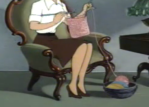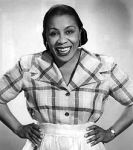Animated cartoons from 1930s to early 1950s, Tom and Jerry featured racial stereotypes.
Mammy Two Shoes
Mammy Two Shoes is a middle aged African American housemaid created by William Hanna and Joseph Barbera, and was voiced by Lillian Randolph in 1940 until 1952.
Mammy takes care of the house, and is often caught in the middle of Tom and Jerry’s scuffles. She’s also Tom’s owner ; he gets told off by her and she wallops him with a broom whenever he is misbehaving.
It was never clear if Mammy was the owner of the house, but by her appearances of wearing a white apron , red slippers and a broom in her hand, it would suggest that Mammy is a housemaid.
Characteristic, what does Mammy mean?
Mammy is known, formerly in southern United States, a black nursemaid or a nanny in charge of white children. They are usually portrayed as an older women that’s overweight with dark skin.
Mammy archetype comes from the memoirs and diaries that emerged after the Civil War with recordings and descriptions of African-American household women slaves who were considered by family members as their black mothers.
This in today’s society is offensive.
Mammy’s face was hidden in most of the episodes and was only seen by the lower half of her body. Mammy was only just a supporting character so the artists were worried that the audiences would draw their attention away from the main characters.
Mammy also appears in Walt Disney cartoons, it’s the same character from the MGM’s Tom & Jerry, and used the same voice actor, she appeared in the Orphans Benefit 1934, Three Orphan Kittens, More Kittens, Pantry Pirate and Figaro and Cleo. Her other name is Ant Delilah.
When Chuck Jones was under supervision of the MGM animation studios he created a censored versions of Tom and Jerry featuring Mammy. They edit Mammy out with rotoscoping techniques and replaced her with a white thin women with a Irish accented in the episode Saturday Evening Puss. The voice was provided by June Foray.
Mammy’s last appearances in the cartoon shorts was in 1952 Push-Button Kitty. In 1954 Mammy was replaced by two white couple Joan and George were the audiences could see the characters faces.
- Joan
- George
As Mammy was partially seen in the cartoon shorts, she was briefly seen in Saturday Evening Puss and Part Time Pal.
Mammy was originally voiced by Lillian Randolph. But in 1992s MGM animation studio the cartoons that featured Mammy were edited again, this time they replace the voice actress to Thea Vidale, because the use of potentially offensive dialect.
- Lillian Randolph 1940–1952
- Thea Vidale 1989–2001
Gene Deitch who directed Tom and Jerry shorts in 1961 said “ The stereotypical black housekeeper, didn’t work in a modern context”. Mammy was removed from production, and Tom had new owner Clint Clobber, a corpulent white middle class man, who is more brutal in punishing his pets when they make mistakes. From 1962 to1964 Toms owner was changed again, to a modern white women, who had her own apartment.
In Tom and Jerry Tales 2006 Mammy return but was redesigned and know as Mrs Two shoes, they kept the aspects of her personality but changed her skin tone to white, to avoid any controversy.
Mammy Two Shoes, after all she is the archetype of the black women working for a white family from the South USA, in the mid 20th century. When such women did not have the vote.
It’s us deeply patronising to suggest that modern day families are watching historical cartoons when values were different. Does certain people think by watching Tom and Jerry and seeing Mammy it will turn our children into racists. Believing she is the norm, this is a part of our history its no good airbrushing it.

















